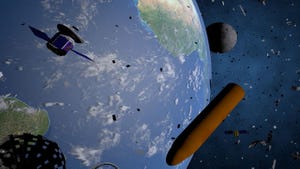
'Worst-Case Scenario' Space Junk Collision Barely Avoided - CNET
Low-Earth orbit — home to satellites, spacecraft and the International Space Station — is full of debris. And a heart-pounding near-miss between a rocket body and a dead satellite on Jan. 27 highlights just how junky it’s gotten around our planet.
In a series of tweets last week, space debris tracking company LeoLabs laid out what happened.
Two pieces of Russian space debris, an SL-8 rocket body and the defunct Cosmos 2361 satellite, came within an estimated 6 meters (20 feet) of each other, with a margin of error of a few tens of meters. “Too close for comfort,” LeoLabs tweeted.
Too close for comfort… 😳
Two large, defunct objects in #LEO narrowly missed each other this morning — an SL-8 rocket body (16511) and Cosmos 2361 (25590) passed by one another at an altitude of 984km. 🚀⚠️ #SpaceDebris pic.twitter.com/pF9o6BuZ5Q
— LeoLabs (@LeoLabs_Space) January 27, 2023
LeoLabs said the near-miss happened in what it calls a “bad neighborhood,” an area of orbit with a lot of derelict objects.
“We’ve identified this kind of collision — between two massive derelict objects — as a ‘worst-case scenario’ because it’s largely out of our control and would likely result in a ripple effect of dangerous collisional encounters,” the company tweeted. A collision could have created thousands of new fragments. More debris means more chances of future collisions in orbit.
The ISS and functioning satellites and spacecraft stand a chance of moving out of the way of hazardous objects. The ISS performs collision avoidance maneuvers as needed. For example, it dodged a piece of Russian space junk in late 2022. But defunct items like the rocket body and satellite can’t get out of each other’s way.
The close call is a stark reminder of how orbit is getting more crowded. LeoLabs has called for debris mitigation and remediation efforts, including investment in debris removal missions, to battle the problem. Researchers are investigating potential debris removal technologies, from a giant claw to a harpoon. In the meantime, junk keeps piling up.

